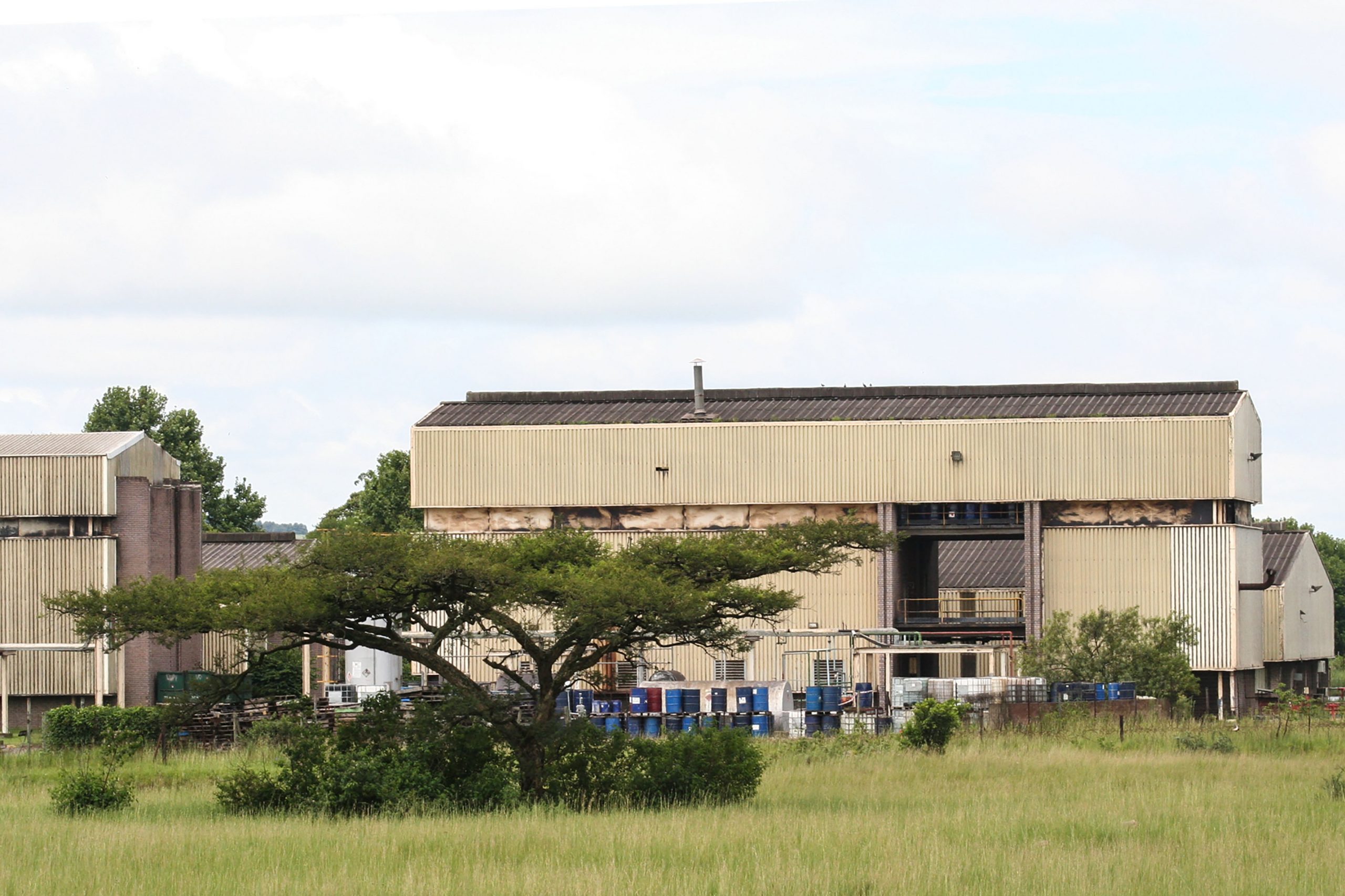Thor Chemicals’ toxic waste goes up in flames
Another cache of South Africa’s stockpile of dumped mercury has burned at the old British-owned Thor Chemicals factory near Durban, just two weeks after the environment minister visited the site.…
Author:
2 September 2019

Car crashes, factory fires and other things that go bump in the night often have a funny smell about them.
Barely 24 hours before former Bosasa boss Gavin Watson died in an early morning car smash in Johannesburg, firefighters in KwaZulu-Natal were busy hosing down a massive fire that broke out in the early hours at a warehouse containing more than 3 000 tonnes of toxic sludge.
The cause of the fire remains unclear. It started in the early hours of Sunday 25 August 2019, barely two weeks after Minister of Environment, Forestry and Fisheries Barbara Creecy visited the factory to inspect the waste and discuss how to deal with it – at a projected cost of R300 million.
Remarkably, this cache of poisonous chemical waste has been piling up in a rural area near the town of Cato Ridge since the 1980s, imported into the country from foreign nations that wanted to get rid of a headache.
Related article:
More than three decades later, however, its eventual fate seems no closer to a conclusion, despite a commission of inquiry appointed by former president Nelson Mandela finding that the apartheid government had “grossly mishandled” the toxic waste build-up at Thor Chemicals.
Dennis Davis, the professor who chaired the commission, urged Mandela’s government in 1997 to develop a plan to treat or dispose of the stockpile in an environmentally friendly manner.
The Department of Environment, Forestry and Fisheries has not been able to quantify exactly how much of the waste was incinerated in the blaze. But officials confirmed that members of the Environmental Management Inspectorate – environmental enforcement officials from different government departments known colloquially as the Green Scorpions – and the police have launched a joint investigation.
The department said it was unable to comment on the potential public health risks from the toxic plume of airborne emissions from the factory, which is about 48km from central Durban.
Levels of toxicity
Mercury is a potent neurological poison. The damaging effects to the human brain gave rise to “mad hatter disease”, a condition common among England’s hatmakers with their prolonged exposure to the vapours of the mercury they used to make felt hats.
According to the World Health Organisation (WHO), exposure to even small amounts of mercury can cause serious health problems and damage the development of children in the womb and early stages of life. The WHO rates it among the top 10 chemical elements of major public health concern with its toxic effect on the nervous, digestive and immune systems as well as the lungs, kidneys, skin and eyes.
Related article:
Because it is bio-magnified through the food chain, large predatory fish such as tuna and sharks are more likely to have high levels of mercury as a result of eating smaller fish containing mercury from ingesting plankton.
One of the best-known examples of mass mercury poisoning happened in Japan, where more than 2 000 people died and at least 10 000 others became sick after eating seafood poisoned by a chemical company that dumped mercury waste into Minamata Bay.
Burning mercury and other toxic waste can also generate emissions of even more deadly chemical by-products, such as dioxins and furans.
Several workers have already died or been poisoned after being exposed to mercury fumes while working at the Thor Chemicals factory.
A poisonous history
Thor, which began its mercury operations in Margate, England, moved some of its operations to South Africa when its worker safety record came under scrutiny by the English health and safety authorities.
Initially based in Pinetown, the British multinational company moved to Cato Ridge in 1982, where it established mercury operations and employed new, unskilled staff from rural KwaXimba.
The first signs of trouble emerged in 1988 when a Natal Parks Board scientist found several grossly deformed tadpoles and frogs in the streams surrounding the Thor factory. The tadpoles also contained extremely high levels of mercury.
In the early 1990s, Greenpeace researchers found high levels of mercury in sediment downstream from the Thor factory, close to the township of Fredville.
Soon afterwards, the first human casualties emerged when several workers from Thor were sent to hospital suffering from suspected mercury poisoning.
Related article:
The dead workers included Peter Cele, who died in an emaciated condition in King Edward VIII Hospital in Durban in 1993. Other casualties were Engelbert Ngcobo, Frank Shange and Felix Mhlanga. Scores of other workers also fell ill. Petrus Mkhize had his left foot amputated after it turned black and went numb.
Nearly a decade later, fishing was banned at Inanda Dam (Durban’s largest source of drinking water) after the Medical Research Council found high levels of mercury in the muddy sediment around the dam. The researchers also found elevated levels of mercury in hair samples collected from several local residents, although the exact source of the pollution remains unclear.
Thor, meanwhile, came under pressure from Greenpeace and the local Environmental Justice Networking Forum and, in 1995, Mandela appointed a commission to examine the safest way to treat or get rid of the stockpile of mercury waste at Thor.
According to the commission report, Thor received mercury-based waste from several chemical companies, including an AECI facility in Sasolburg, Borden Chemicals, Calgon Carbon Corporation and American Cyanamid (United States), Thor (United Kingdom) and other companies in Europe, South America, the Middle East and Indonesia.
Commission chair Dennis Davis concluded that “it must have been clear to any reasonable person … [that] matters had got out of control” and that imported waste could not be treated safely at Thor.
“At this point, probably in the late 1980s, Thor should have both refused to accept further waste and initiated fresh but urgent steps to solve this growing problem,” he said.

Who will be held to account?
Government regulators did not come out smelling too good either, having failed to hold Thor to account.
Three Thor managers were eventually taken to court and charged with culpable homicide, but these charges were later dropped and the company pleaded guilty to a number of safety violations and ended up paying a R13 500 fine.
Thor – by then facing additional injury and compensation claims from South African workers in English courts – began to change its corporate shape. Following a demerger process, a new company, Tato Holdings, emerged in the UK. Thor Chemicals in South Africa ceased to exist in name after a number of new entities emerged under the names of Metallica, Guernica and Acti-Chem.
Behind the scenes, company and government attorneys wrangled over who would pay the cost of clearing up the mess. At one point there was a proposal that the toxic legacy at Cato Ridge be entombed in concrete forever, while government and lobby groups pushed for the waste to be shipped back to the senders or to a company in Switzerland for final treatment and disposal.
The A-Thermal Retort Technologies (formerly Thermopower) plant in Olifantsfontein, north of Johannesburg, burnt to the ground on 12 September 2013, reported groundWork.
Destroyed in the blaze was mercury waste from Thor’s old factory in Cato Ridge.
Now, six years later, another big fire has consumed a further chunk of the original stockpile of 3 299 tonnes.
Wasteful system
Environmental department spokesperson Albi Modise said the minister had not issued a directive or final ultimatum to factory management at Cato Ridge.
“The minister went to the site since she was concerned that there had been no movement in the past five years. The minister wanted to appraise herself of the extent of the problem at the site, hence the visit.
“The minister did not give any directives when she visited the site, save to indicate that she has instructed the Environmental Management Inspectors to issue Thor Chemicals, which is based in the United Kingdom, with the South African government’s intention to issue a directive.”
He said Thor had been informed of the government’s intention to hold them liable for the treatment or safe disposal of this waste.
“The only treatment option currently available is at a company situated in Switzerland … It has been estimated that the costs for the removal and disposal of this material would be in the region of R300 million.”
A convenient fire
Pietermaritzburg-based environmental justice group groundWork has described the Cato Ridge blaze as a very “convenient” fire.
“In 1993, the ANC, as a government in waiting, took a deep interest in this worker and environmental justice case. Soon to be president, Nelson Mandela visited Thor employee Engelbert Ngcobo on his deathbed, acknowledging the injustice that the poor and least responsible bear [for] the highest burden of pollution.”
“It is mysterious that warehouses storing the imported toxic waste have now burnt down, just when Minister Creecy, as a new minister, has sought to challenge this. This is indeed an early test for her tenure as minister. Will she vigorously seek answers and hold the industry to account?” asked groundWork director Bobby Peek.
Related article:
Referring to several recent cases of pollution, including a toxic spill and fish killed in the Msunduze River near Pietermaritzburg and a factory fire in Wentworth, Durban, groundWork has called for the government to make available all documents relevant to these cases, “including any emergency monitoring of air, ground and water pollution, or, more tellingly, if indeed government has not done this”.
“If the South African government is serious about worker and environmental justice, it must act with urgency and meaning,” said groundWork.
Officials from Thor in the UK and Metallica in Cato Ridge had not responded to email queries at the time of publication.
Amendment, 2 September 2019: A reference to a Noseweek report on the blaze at the A-Thermal Retort Technologies plant in Olifantsfontein was replaced with a reference to a groundWork report on the same fire.




